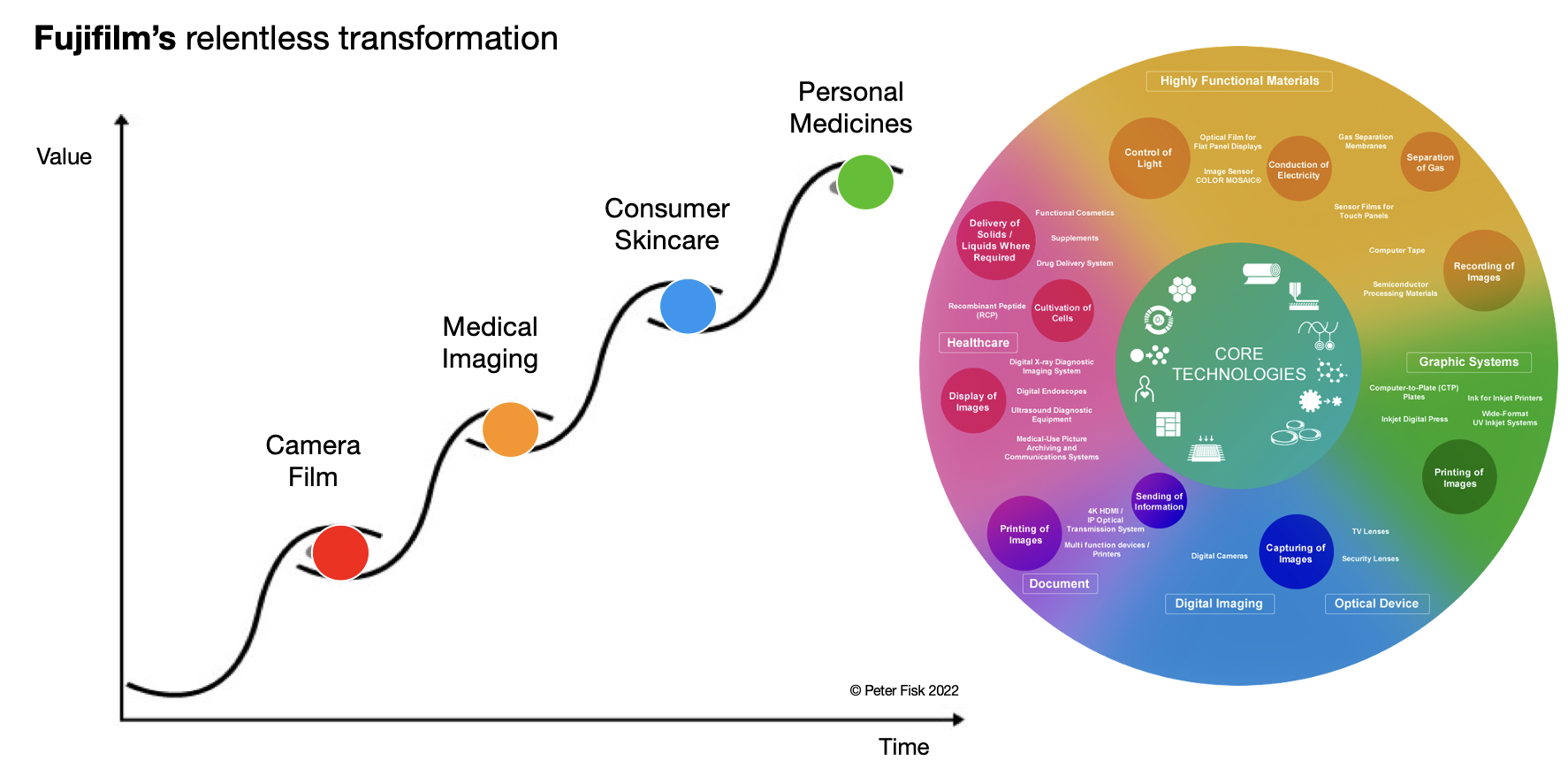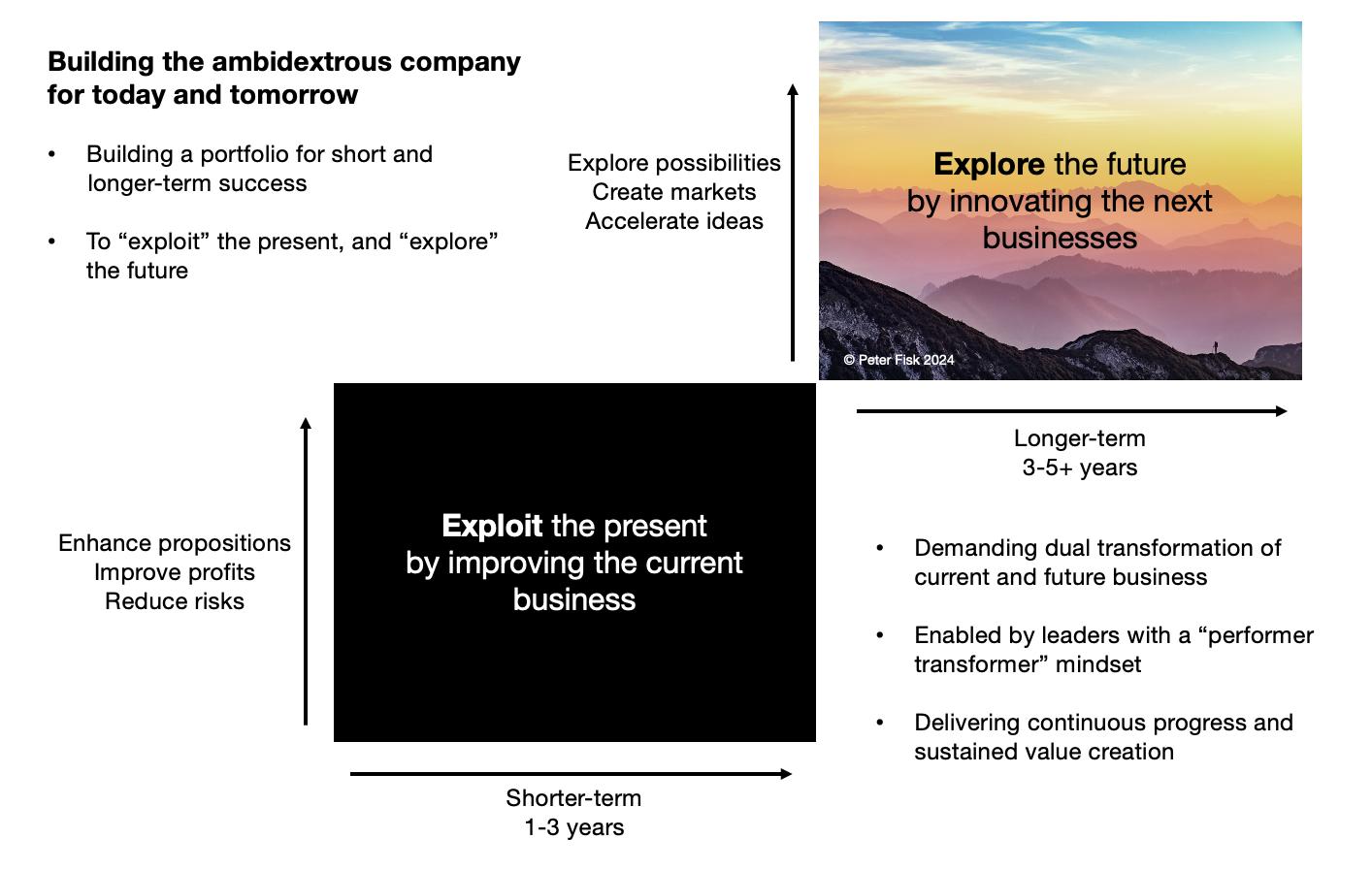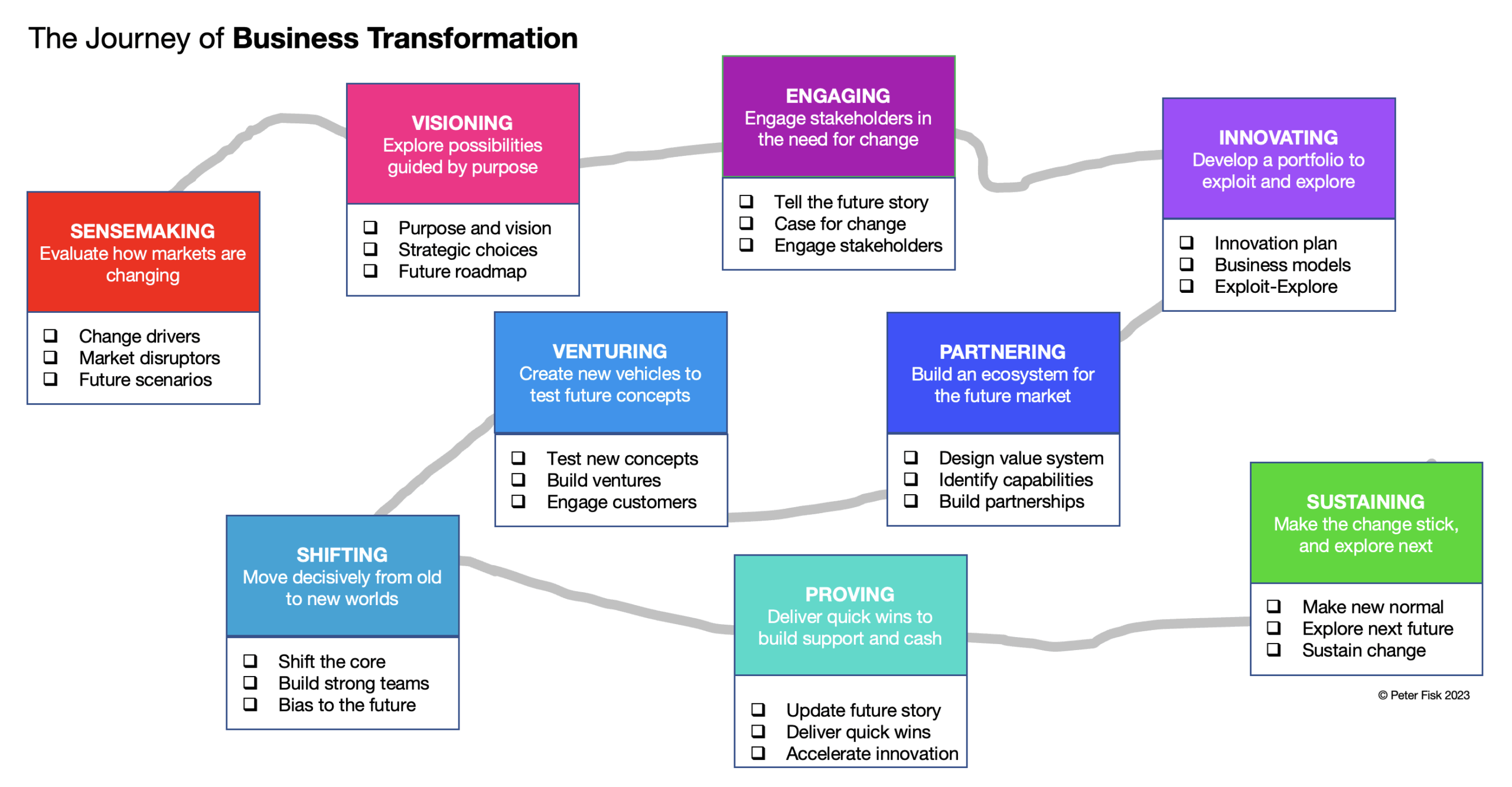Business Transformation … the new superpower of business leaders … reimagining the future, redefining strategy, reinventing the organisation, rewiring performance … the journey to deliver step change in value creation
June 8, 2025

In today’s world of accelerating change, disruption is no longer the exception, it is the norm.
Technology, climate imperatives, shifting customer expectations, and geopolitical volatility are reshaping the business landscape. In this environment, incremental improvement is no longer sufficient. True business transformation—a fundamental reinvention of how a company creates and captures value – is necessary for survival and long-term success.
But what does transformation really mean? At its core, transformation is about reimagining the future of the business: what it stands for, how it competes, how it works, and how it wins. It’s a step beyond operational change or digital upgrades. It is a whole-system shift—combining purpose, strategy, operating model, culture, capabilities, and performance.
What is business transformation?
Business transformation involves a step change in performance driven by a shift in core business logic—how value is created and delivered. This could mean moving from products to platforms, from fossil fuels to renewables, from a local to a global model, or from analogue to digital. In some cases all of these.
True transformation usually touches four interconnected domains:
-
Reimagining purpose and vision – defining the ‘why’ of the organisation; its role in a rapidly changing world, its aspirations, and what it uniquely offer, supported by a vision of what better can look like.
-
Redefining strategy and priorities – refocusing ‘where and how’ to play – reshaping the strategy, business model, customer propositions, innovating products and services, and future business portfolio.
-
Reinventing culture and organisation – creating the internal conditions—leadership, mindset, capabilities, behaviours, structures, and systems—that enable change and innovation.
-
Rewiring operations and performance – shifting the core activities, capabilities, and technology infrastructure to support new ways of working, and delivering performance short and long-term, for sustained value creation.
At its best, business transformation results in significant growth, market leadership, and renewed relevance. It can mean, over time, a fundamental shift in the core business. It can transform performance, creating significant new profit streams, and doubling or tripling the market value over 4-5 years. At its worst, it is superficial, disconnected, and fails to deliver impact. All the more reason to get it right.

Transformational companies around the world
Some companies have stood out in recent years for their ability to successfully reinvent themselves, responding to massive shifts with agility and vision.
DSM … science-led reinvention
Originally a Dutch coal mining company, DSM has continuously reinvented itself for over a century. Most recently, it divested from chemicals and refocused on biosciences, nutrition, and health. The merger with Firmenich accelerated this pivot, creating a purpose-driven leader in sustainable ingredients. DSM’s transformation illustrates how companies can shed legacy businesses to focus on high-growth, impact-led markets.
Schneider Electric … the world’s most sustainable company
Once a provider of electrical components, Schneider Electric transformed into a global leader in energy management and automation. Its purpose—“to be the digital partner for sustainability and efficiency”—has guided a decade-long pivot towards software, smart systems, and decarbonisation. The company reorganised around digital platforms and embedded sustainability into every part of its strategy and culture. It now helps thousands of companies monitor and reduce their carbon footprint while achieving sustained double-digit growth.
Fujifilm … from camera film to healthcare
When digital photography disrupted its core market, Fujifilm—unlike Kodak—chose to radically reinvent itself. It leveraged its deep expertise in chemistry and materials to pivot into healthcare, cosmetics, and advanced materials. Its diversification into medical imaging, regenerative medicine, and pharmaceuticals allowed it not only to survive the death of film but to thrive in new sectors. Fujifilm’s transformation is a masterclass in strategic foresight, reinvention of capabilities, and disciplined execution.

Ping An … from insurer to multi-sector ecosystem
Ping An, one of world’s largest insurers, has undergone a radical transformation into a technology-driven ecosystem for financial and healthcare services. Recognising the disruptive potential of digital platforms, Ping An invested in AI, blockchain, and cloud, creating industry-leading apps like Good Doctor (healthcare) and Lufax (finance). Its strategy involved turning traditional financial services into tech-powered, data-rich customer experiences—while also developing internal AI tools to increase operational efficiency. Ping An’s transformation exemplifies how traditional players can redefine their core by embedding technology at scale.
Microsoft … ready to win in an age of AI
Under CEO Satya Nadella, Microsoft reimagined itself from a PC-centric, legacy software firm into a global cloud powerhouse. Nadella reinvigorated Microsoft’s purpose “to empower every person and every organization on the planet to achieve more,” steering it towards cloud infrastructure (Azure), remote collaboration (Teams), and generative AI (Copilot). The transformation was cultural as well as strategic—moving from internal rivalry to openness and innovation. The result: a trillion-dollar leap in market value and renewed relevance.
IKEA … from flatpacks to circularity
IKEA has evolved from a low-cost furniture retailer to a purpose-led sustainability leader. It has committed to becoming climate positive by 2030, embraced circular product design, and explored new service models including buy-back, rentals, and urban formats. The transformation includes not only rethinking its supply chain and materials, but also transforming its culture—empowering employees to innovate and enabling faster experimentation.
On … scaling a start-up into lifestyle leader
Swiss sportswear brand On Running combines elite performance with sustainability. Its transformation is unique—scaling rapidly while maintaining its core design ethos and environmental focus. The CFO played a pivotal role, helping develop a circular subscription model for recyclable shoes and using data to optimise global expansion. It exemplifies how newer companies can build transformation into their growth journey from the start.
Relentless reinvention … once you’ve transformed, transform again
Business transformation, of course, is no longer a one-off project, it’s a relentless, continuous process. As markets evolve due to technological disruption, shifting customer expectations, environmental challenges, and geopolitical uncertainty, companies must constantly reinvent themselves to stay competitive. Transformation is not just about reacting to change; it’s about building the capabilities to anticipate, shape, and lead it.
This requires becoming an ambidextrous organisation—able to simultaneously optimize today’s core business while exploring and scaling tomorrow’s opportunities. It means balancing operational efficiency with strategic innovation, and fostering cultures where adaptability and experimentation thrive alongside discipline and performance.
Amazon exemplifies this duality, continually reinventing its model—from retail to cloud services, logistics, and AI—while maintaining tight operational excellence. Schneider Electric has pivoted from hardware manufacturing to smart energy solutions, combining legacy strengths with digital innovation. DBS Bank, once a slow-moving institution, has transformed into a technology-driven, customer-centric bank by embedding agile practices and a startup mindset across the organization.
Agility is central to this model—organizational structures must be flexible, decision-making decentralized, and leadership aligned on a shared purpose. Spotify’s “squad” model, for instance, empowers cross-functional teams to experiment quickly and bring new value to market fast.
Many organisations seek to build a dual approach to transformation, most simply illustrated by the double portfolio of “exploit and explore” – developing a portfolio of initiatives to enhance today’s business, while also initiatives to create the future. You need to work on both, and gradually explore becomes exploit. Some companies do this structurally like Ping An, with co-CEOs, one exploiting its core insurance business, the other developing new businesses in healthcare, mobility and real estate. Or think about Alphabet’s X company, working on exploring the future beyond search. Investors, of course, seek both.
Ultimately, transformation is no longer about fixing broken parts; it’s about continuously reimagining the whole—products, models, ecosystems, and ways of working. Businesses that embed this capacity to evolve—who see reinvention as a muscle, not a moment—will be best placed to thrive in an age where change is the only constant.

3 of the biggest challenges for transformation
Even the most visionary leaders face deep challenges in delivering transformation at scale. Three of the most critical and complex leadership challenges are balancing a portfolio of innovations, navigating dual transformation (external and internal), and aligning the board and executive team.
1. Balancing today and tomorrow
Leaders must manage a dynamic portfolio of innovations that span immediate improvements and longer-term reinvention. This means simultaneously optimising the core business (Horizon 1), incubating adjacent innovations (Horizon 2), and exploring radical new ventures (Horizon 3). The challenge is resource allocation: how to invest in transformative opportunities without compromising current performance. Leaders must create space for experimentation while maintaining operational excellence. This tension between “running the business” and “changing the business” often stretches leadership focus and organisational attention. This demands leaders who are performer-transformers, and a dual transformation approach.
2. Combining strategic and organisational change
Transformation must occur both externally—through a new strategic vision, value proposition, and business model—and internally, through organisational structure, culture, processes, and capabilities. It’s not enough to define a new direction; leaders must also mobilise the company to deliver it. This requires orchestration across functions, integration of digital and sustainability agendas, and active engagement with customers, partners, and ecosystems. Internally, leaders must rewire the organisation for agility, collaboration, and learning. That means letting go of legacy hierarchies, empowering cross-functional teams, and developing new talent and mindsets. Strategic ambition must be matched by organisational readiness.
3. Aligning the board and executive team
Perhaps the most overlooked but critical challenge is aligning the leadership at the top. True transformation starts with a shared dream—a compelling vision that stretches beyond today’s constraints. Yet many boards are anchored in risk management and short-term financials, while transformation requires bold bets and long-term thinking. Leaders must bridge this gap, building trust, framing transformation in terms of future value creation, and managing performance across multiple time horizons. Within the executive team, cohesion is vital: alignment of goals, clarity of roles, and a shared commitment to lead the change. Without unified leadership, even the best strategies falter.
In short, transformation is as much about leadership as it is about strategy. It demands courage, coherence, and collaboration across the leadership system to shape the future and deliver it with discipline.

Accelerating the transformation journey
While every company’s journey is unique, successful transformations tend to follow several common principles and practices:
1. Start with purpose
Transformation is more likely to succeed when anchored in a compelling, future-facing purpose. Purpose inspires stakeholders, provides clarity during uncertainty, and guides strategic choices. Companies like Unilever and Danone have demonstrated how a strong sense of purpose can align business transformation with broader societal needs.
2. Envision a bold future
Companies need to articulate a bold vision—not just improve the present. A compelling narrative about the future energises teams and creates direction. Disney, for instance, didn’t just go digital—it reimagined itself as a streaming-first, direct-to-consumer company.
3. Redesign the business model
Transformation involves rethinking how the business creates and captures value. This may involve shifting from selling products to services, building platforms, or monetising data. Adobe transitioned from packaged software to cloud subscriptions. Ørsted moved from fossil fuels to renewable energy production. These moves require strategic courage and long-term investment.
4. Make culture a strategic asset
Culture often makes or breaks transformation. Companies need to foster learning, psychological safety, accountability, and openness to change. Microsoft’s cultural reset—from “know-it-alls” to “learn-it-alls”—was a critical enabler of its business transformation.
5. Invest in capability building
Transformation demands new skills—in AI, customer experience, sustainability, or agile working. Leading companies build these capabilities through training, hiring, and partnerships. DBS Bank, for example, turned itself into a “technology company in banking,” with internal accelerators and digital talent programs.
6. Structure for process and cultural agility
Legacy hierarchies often slow down transformation. High-performing companies redesign around networks, cross-functional teams, and empowered local units. Amazon’s “two-pizza teams” and Spotify’s squad model are iconic examples of agile structures supporting innovation.
7. Operationalise with systems and metrics
Transformation should be operationalised—translated into targets, incentives, and accountability systems. Schneider Electric embedded sustainability KPIs across the organisation, ensuring that purpose translated into performance.
8. Deliver quick wins while shaping the long term
Transformation is a marathon, but quick wins build momentum. Successful leaders sequence transformation to deliver near-term impact—such as new product lines, cost savings, or customer wins—while building the foundation for longer-term shifts.

Transformation as a leadership imperative
Great business transformations start with great leadership. In times of radical change, leaders play an essential role—not just as decision-makers, but as visionaries, mobilisers, architects, and role models. They must be bold enough to imagine a future beyond today’s business model, and disciplined enough to bring it to life across the entire organisation.
Here’s a detailed breakdown of what leaders must do to drive successful transformation—starting with vision, and following through with strategy, organisation, and execution—along with powerful real-world examples.
1. Have the courage to imagine a different future
The first and most critical responsibility of a transformative leader is to define a new vision that breaks from legacy logic. This demands courage—because it often involves letting go of what made the company successful in the past.
- Challenge the status quo. Leaders must ask: What business are we really in? What future could we shape—not just survive? They must be willing to explore and articulate a future that may not yet exist in their industry.
- Inspire ambition. A bold vision isn’t just a stretch target—it’s a compelling narrative about how the organisation can solve bigger problems, serve new needs, or change how value is created.
Satya Nadella became CEO in 2014 when Microsoft was in decline. He reframed its purpose as “empowering every person and every organization on the planet to achieve more,” moving beyond Windows to cloud, AI, and collaboration tools. His vision reinvigorated the company—and set the direction for all future strategy and culture.
Masahiko Uotani redefined Shiseido’s identity in the face of stagnation —from a Japanese cosmetics brand to a global beauty innovator focused on skin science and wellness. This allowed the company to pivot strategically into health, tech, and sustainability.
2. Translate vision into strategy and bold priorities
Vision without strategy is just a dream. Leaders must translate vision into clear, actionable priorities that redefine how the company competes.
- Redefine the business model. This might involve shifting from products to services, analog to digital, or linear to circular models. Leaders must make deliberate choices about where and how to play.
- Create new value propositions. What does the customer of the future need? Leaders must reimagine how they deliver value—and sometimes who they serve.
- Make hard trade-offs. Strategy is about focus. Leaders must say no to legacy businesses or behaviours that don’t support the transformation.
Henrik Poulsen led Ørsted’s exit from fossil fuels, reorienting the business around offshore wind. The strategy was clear: become a global leader in renewable energy. This meant divesting legacy assets and doubling down on future growth, even when it meant short-term pain.
Peter Ma led Ping An’s transformation from a traditional insurer into a tech-powered ecosystem. He strategically invested in AI, blockchain, and platforms like Good Doctor and Lufax—turning disruption into opportunity.
3. Mobilise the organisation and lead cultural change
No transformation succeeds without people. Leaders must create the conditions—mindsets, structures, and behaviours—for the organisation to embrace the future.
- Model the new mindset. Leaders must embody the values and behaviours they expect. If they want curiosity, agility, and collaboration, they must live them daily.
- Flatten hierarchy and empower teams. Organisational agility is critical. Leaders should enable cross-functional teams, decentralised decision-making, and rapid learning.
- Create psychological safety. Transformation involves risk and failure. Leaders must build trust, reward experimentation, and make it safe to speak up.
Shigetaka Komori led a deep cultural shift at Fujifilm, from a traditional, hierarchical firm to an entrepreneurial, innovation-led company. He protected R&D budgets during crisis and empowered teams to explore healthcare and materials science as new business areas.
Piyush Gupta transformed DBS Bank into “a tech company in banking.” He broke silos, invested in digital skills, and created an innovation culture that permeated all levels. DBS now regularly ranks among the world’s most innovative banks.
4. Align Systems, capabilities, and resources
Once strategy is defined and culture is shifting, leaders must align the business system to support the new model. This means rewiring the organisation for execution.
- Build future-ready capabilities. Leaders need to invest in the skills, technologies, and partnerships/ecosystems that the new strategy requires—whether it’s AI, sustainability, digital, or data.
- Redesign metrics and incentives. People do what they’re measured and rewarded for. Leaders must update KPIs, dashboards, and incentives to reflect transformation goals.
- Fund the future. Capital allocation is critical. Leaders must direct investment toward the bold bets—while responsibly managing legacy operations.
Jean-Pascal Tricoire embedded sustainability into the Schneider Electric’s performance metrics, linking executive pay to ESG outcomes. He built capabilities in digital energy and IoT, aligning strategy, talent, and structure to make sustainability a core growth engine.
Shantanu Narayen led Adobe’s shift from boxed software to cloud subscriptions. This meant new pricing, capabilities, and go-to-market models. The company retrained teams, revamped platforms, and restructured to deliver recurring customer value.
5. Sustain momentum and communicate relentlessly
Transformation isn’t a single initiative—it’s a multi-year journey. Leaders must maintain belief, energy, and accountability through ambiguity and change.
- Celebrate progress. Leaders must share quick wins, milestones, and success stories to maintain momentum, the belief and desire for change, and deliver progress.
- Communicate consistently. A compelling transformation story should be repeated often—internally and externally—so everyone understands the vision, their role, and the journey ahead.
- Evolve as the future unfolds. Leaders must stay adaptive, revisiting assumptions and updating direction as conditions change. Transformation never really ends.
Paul Polman made sustainability the centre of Unilever’s strategy and communicated it constantly—with investors, employees, and customers. He built long-term credibility and trust by showing how purpose and profit could reinforce each other.
John Iossifidis sustained momentum at Al Ghurair by driving transformation progressively at all levels, built around a strong sense of shared, meaningful purpose and vision, then empowering business units and managers to innovate and transform.
Relentless reinvention, the engine of value creation
Here are some compelling examples of the performance impact of business transformation, showing how companies that reimagined their purpose, strategy, and organisation achieved substantial profit growth, market value gains, and long-term resilience—often from entirely new business areas.
- Fujifilm‘s operating profit from new business segments grew by over 400% from 2010 to 2023. Market cap rose from around ¥1.5 trillion in 2010 to almost ¥6.5 trillion in 2024, a 4x growth in value creation.
- Microsoft‘s cloud revenues grew from $6.3B in 2015 to over $117B in 2024 (Azure, Office 365, Dynamics). Market cap rose from $340B in 2014 to over $3 trillion by 2024, which is a 780% increase.
- Schneider Electric‘s doftware and services now contribute around 50% of revenues and growing. Share price increased from €60 in 2015 to over €220 in 2024, reflecting nearly 4x market cap growth.
- PingAn’s tech platform revenue grew to 15% of total group revenue, from almost zero in 2013. Group market cap rose from $60B in 2010 to over $200B by 2021. Return on equity consistently above 18–20%.
- DSM‘s EBITDA margins improved by ~400 basis points over 10 years. Share price rose from €40 in 2010 to €160+ by 2022 representing 4x growth in market value.
- Unilever‘s “Sustainable Living Brands” grew 69% faster than the rest of the portfolio and delivered 75% of growth (2019). Market cap increased from £70B in 2010 to over £110B+ by 2024, despite market volatility.
Transformation is not a one-off change, but a journey over many years of many change projects, and ultimately becomes an ongoing capability. In an era of rapid disruption and rising stakeholder expectations, companies must continuously reinvent themselves to stay relevant and create value.
The leaders who succeed have their heads up not heads down – not just managing their companies, but shaping their futures.
More from the blog